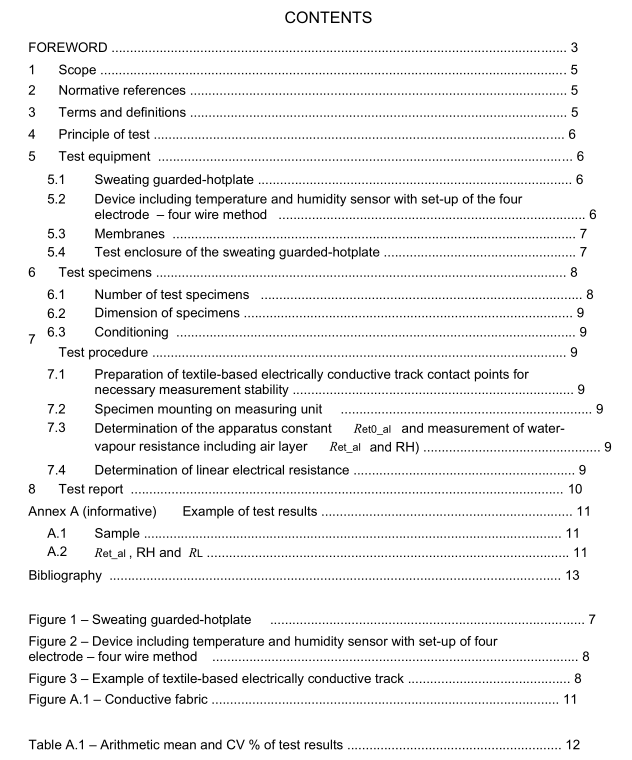IEC 63203-201-3 pdf – Wearable electronic devices and technologies – Part 201-3: Electronic textile – Determination of electrical resistance of conductive textiles under simulated microclimate

IEC 63203-201-3 pdf – Wearable electronic devices and technologies – Part 201-3: Electronic textile – Determination of electrical resistance of conductive textiles under simulated microclimate
3.3
microclimate
climate of the small air layer(between the skin and the clothing or between textiles and sweatingguarded-hotplate)
Note 1 to entry: This microclimate has specific temperature and humidity characteristics. Simulated microclimate isthe climate of the air layer between fabric and sweating guarded-hotplate.
[SOURCE: ISO 21232:2018,3.2, modified – A hyphen has been added to the term “sweatingguarded hotplate” and the second sentence in the note has been added.]
3.4
water-vapour resistance including air layerRet_al
water-vapour pressure difference between the two faces of a material (separated from eachother by 5 mm) divided by the resultant evaporative heat flux per unit area in the direction ofthe gradient
Note 1 to entry: Water-vapour resistance is measured under the simulated state in which the air layer existsbetween the skin and clothing-
Note 2 to entry: Water-vapour resistance including air layer is expressed in square metres pascal per watt.[SOURCE: ISO 21232:2018,3.3]
4Principle of test
Clothing comfort depends on the environmental conditions(humidity,temperature) of themicrodlimate between the skin and the fabrics when clothing is worn.The e-textile system made
of conductive fabrics is in direct contact with human skin so that the electrical resistance ofconductive fabrics is affected by the microclimate between human skin and fabric. Therefore,this test method can perform the combined measurement of electrical resistance using themeasurement principle of the four-wire Kelvin method and a DC current source,under asimulated microclimate.
5 Test equipment
5.1Sweating guarded-hotplate
For the test device, the sweating guarded-hotplate (see Figure 1), specified in ISO 11092:2014,is used.The upper part is a measuring unit with temperature and water supply control and thelower part is a thermal guard with temperature control.
5.2 Device including temperature and humidity sensor with set-up of the four
electrode – four wire method
5.2.1 The device shall be made of electrically non-conductive material.The device is usedto create space for the air layer between hotplate and specimen.The sensor inside the devicemeasures the microclimate between hotplate and specimen, specified in ISO 21232:2018(seeFigure 2).
5.2.2 An electrical current source, a voltage-meter and contacting electrodes measure electrical resistance. Electrodes shall be arranged for using the set-up of the four electrode – four wire method on the device and shall cover the whole width of the textile-based electrically conductive track, specified in EN 16812:2016, 6.2 (see Figure 2 and Figure 3). The electrodes shall be placed parallel to each other and they shall be movable forwards and backwards.
5.2.3 The specimen is fixed by magnets in the device. The diameter and thickness of the magnet are (5,0 ± 0,2) mm and (3,0 ± 0,1) mm, respectively. The magnetic flux density shall be higher than 0,3 T. The interval between magnets shall be less than 50 mm in the test device (see Figure 2).
5.3 Membranes A water-vapour permeable but liquid-water impermeable membrane shall meet the requirements specified in ISO 11092:2014, 7.1.2.1 or in ISO 21232:2018, 5.4. 5.4 Test enclosure of the sweating guarded-hotplate The requirements specified in ISO 11092:2014, 5.3 shall be met.









